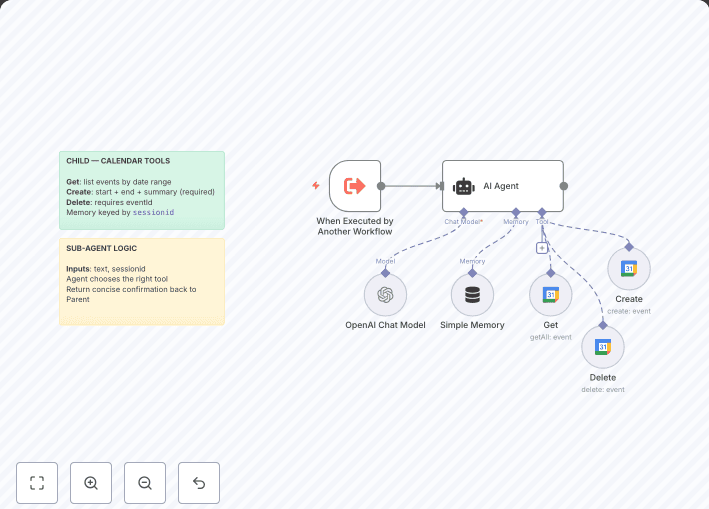AI-Powered Invoice Extraction & Automation System Workflow
Aim
The aim of the Invoice Data Automation workflow is to streamline invoice processing by extracting, validating, and storing invoice details automatically. It uses AI to read invoices (from images/PDFs), structures the data in JSON, checks for missing or duplicate entries, and records the information in a Google Sheet while also uploading the original invoice to Google Drive. Additionally, it sends email notifications for successful entries, duplicates, or missing fields.
Goal
The goal is to:
- Allow users to upload invoice images/files via chat.
- Extract invoice data using AI and format it into a structured JSON.
- Validate mandatory fields like
invoice_id, shop_name, date, Total, and items.
- Check if the invoice already exists in the Google Sheet.
- Append new invoices to Google Sheets and upload the original file to Google Drive.
- Notify the user via email about success, duplicates, or errors.
This ensures that invoices are processed accurately, efficiently, and securely with minimal manual effort.
Requirements
The workflow relies on specific components and configurations:
n8n Platform
The automation is built and hosted on n8n , which orchestrates the entire workflow.
Node Requirements
- When chat message received – Triggers the workflow when a user submits an invoice.
- Analyze image1 – Uses Google Gemini Vision AI to extract invoice data from the uploaded file.
- AI Agent1 + Google Gemini Chat Model1 – Restructures the extracted data into strict JSON format.
- Make data in JSON structure format – Prepares and organizes the structured output.
- Get data – Looks up the Google Sheet to check if the invoice already exists.
- check if Data exist or not in table – Decides whether to process as new data or duplicate.
- New data add using payload / Check Mandatory fields – Ensures invoice JSON is valid and complete.
- If – check missing field – Branches based on whether mandatory fields are present.
- no missing field – new data add using payload 2 – Passes only verified invoices forward.
- Append data to sheet – Saves invoice data in Google Sheets.
- Upload invoice to drive – Uploads the original invoice file to Google Drive.
- Send successful email – Notifies the user of successful entry.
- Duplicate entry send mail – Alerts the user if the invoice already exists.
- Send missing field error on mail – Sends an error email if mandatory fields are missing.
Credentials
- Google Gemini (PaLM) API – For AI-based invoice data extraction and formatting.
- Google Sheets API – For storing structured invoice records.
- Google Drive API – For uploading original invoices.
- Gmail API – For sending success, duplicate, and error notifications.
Input Requirements
- Invoice file (Image or PDF).
Output
- Structured invoice data in Google Sheets.
- Original invoice stored in Google Drive.
- Notifications sent via Gmail (success, duplicate, or error).
API Usage
-
Google Gemini (PaLM API):
Used in Analyze image1 and AI Agent1 to extract and structure invoice data. It ensures fields like invoice_id, shop_name, date, and items are clearly formatted.
-
Google Sheets API:
Used in Get data and Append data to sheet nodes to validate duplicates and store new invoices.
-
Google Drive API:
Used in Upload invoice to drive to securely store the original uploaded invoice file.
-
Gmail API:
Used in Send successful email, Duplicate entry send mail, Send missing field error on mail to notify users about the status of invoice processing.
Workflow Summary
The Invoice Data Automation workflow automates the entire process of invoice handling by:
- Receiving invoice uploads via chat.
- Extracting invoice details with AI (Google Gemini).
- Structuring and validating the data in JSON format.
- Checking Google Sheets for duplicates.
- Appending new invoices to the sheet and uploading originals to Google Drive.
- Sending email notifications to keep the user updated on the process outcome.
This end-to-end automation ensures invoices are handled with speed, accuracy, and transparency , reducing manual work and eliminating common errors in invoice management.


